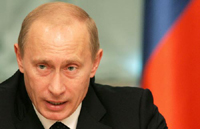Putin’s assassination was meticulously planned seven times
Officials and statesmen have been targeted by terrorists and the like from time immemorial. President Charles de Gaulle of France set a kind of record, surviving numerous attempts on his life. There were a number of attempts on the life of several U.S. presidents. President Abraham Lincoln was shot dead in 1865. President John F. Kennedy fell victim to an assassination in 1963. A terrorist shot and wounded President Ronald Reagan in 1981. Iraqi secret service tried to assassinate President George Bush Sr., in 1993. Were there any attempts on the life of Russian President Putin?

First attempt
The attempt was to have been made on Putin’s life while the president was attending the funeral of Anatoly Sobchak in St. Petersburg, on February 24, 2000. Sergei Devyatov, a press secretary for the Federal Guard Service (responsible for protecting the president), said that “not a psychopath but a certain organization was behind the attempt.”
Second attempt
The attempt was to have been made during an informal summit of the CIS presidents, held in the Ukrainian city of Yalta from August 18-19, 2000. Russian security agencies reportedly received a tip from abroad on the planned attack against President Putin. Four Chechens and several nationals from the Middle East countries were arrested during investigation.
Information with regard to the above attempts is rather scarce since all the documents pertaining to the cases are classified.
Third attempt
The attempt was to have been made during President Putin’s official visit to Azerbaijan on January 9-10, 2002. Azeri security services foiled the attempt, according to a statement by Namik Abbasov, head of the Azeri National Security Ministry, released in October 2001. According to Abbasov, the Iraqi citizen Kyanan Rostam is believed to have intended to carry out the attempt. Rostam was reported to have spent some time in training camps in Afghanistan and had links to Chechen rebels.
Three months prior to Putin’s arrival in Baku, Azeri security agencies received information on the plans to kill the Russian president during his upcoming visit to Azerbaijan. About ten days before the start of the visit, the Azeri security agencies had learned about the delivery of explosives to Azerbaijan. Consequently, Kyanan Rostam, the recipient of explosives, was taken into custody. In January 2002, Rostam was tried and sentenced to 10 years in prison.
Fourth attempt
A Zhiguli 10 pulled into the area within the Kremlin walls about midday on February 6, 2002. A tall man of strong build climbed out of the car. He looked like her was about 40 years old. The man approached the security officers who were apparently taken aback by his sudden arrival. The man said: “My name is Ivan Zaitsev. I’m the President of Russia. Now take me to Vladimir Putin!” Needless to say, the man was handcuffed in no time and taken to the nearest police station for questioning.
The police checked his ID while in custody. Zaitsev’s documents looked in perfect order. His work pass showed that the man was in the employ of a private company. The police sealed Zaitsev’s vehicle and took him to a hospital. The doctors recognized their patient at once. Zaitsev had been brought to the hospital from the same police station a year before. He was detained while trying to drive his Volga into the Kremlin through the Spaskiye Gate during the previous incident.
When questioned by investigators about the reasons behind his illegal entries to the Kremlin, Zaitsev made it quite clear that he was planning to kill President Putin in both cases. According to doctors, a personal tragedy prompted Zaitsev to do what he has done. His elder brother had been murdered six months before the first incident took place in the Kremlin. The crime was reportedly committed in a hideous manner: the police discovered a beheaded body of the brother.
Ivan Zaitsev was going to cut off the head of President Putin. “I’ve got to cut Putin’s head off,” said an entry in his diary. Why did he decide to kill the Russian president? Zaitsev was ready and willing to discuss his reasons while talking to psychiatrists. He told them that he had seen President Putin as a German spy who led Russia to Nazism. He listed the following signs of the onset of Nazism in Russia: steps taken by the government against an independent media; numerous neo-Nazi groups operating across the country; nationwide propaganda of physical education.
Fifth attempt
Not unlike the previous attempt, the fifth one came to naught. The mysterious explosive devices reportedly discovered in the vicinity of Rublevo-Uspenskoye highway vanished without a trace. News agency Regnum reported on the explosives found near the highway on November 28, 2002. According to the news agency, the explosives were discovered at a time when President Putin was supposed to be on the above highway while going back from Kremlin to his residence outside Moscow. The highway, which is regularly used by vehicles carrying high-ranking government officials, was shut off at about 8.45 p.m. for more than two hours on that night. The president’s motorcade took a detour. New reports mentioned 40 kilos of explosives allegedly placed in three metal boxes hidden in a pipe in close proximity to the highway. Other reports said that field engineers had been spotted at work in a forest close to a nearby village.
Before long there were more reports on potential terrorists. The media cited sources claiming that workers had installed new signboards in that section of the highway shortly before the explosives were discovered. Taking into account that a Mercedes with tinted windows was parked near a team of workers, the traffic police apparently interpreted the “energetic activity of unauthorized personnel” as suspicious. The road was closed, and the president’s motorcade detoured around the location via a secondary highway.
It is worthy of notice that one day later the official sources denied all the reports on the incident. The only piece of information that was never denied is the original media report about an attempt in the works.
Sixth attempt
A handmade explosive device was found on the highway connecting St. Petersburg and Pskov on June 23, 2003, several hours before the president’s motorcade was supposed to take the road. A local policeman discovered the device by chance while patrolling the road at night. The device was hidden away in a bag placed under an overpass.
The police and security service called up reinforcements to the scene to deal with the situation. The device proved to be a rather crudely built bomb. No one was hurt. Steps were taken to hush up the incident.
Seventh attempt
According to an article published by the British newspaper The Sunday Times several years ago, the British police foiled a conspiracy aimed at the assassination of President Putin during one of his foreign trips.
Citing representatives of Scotland Yard, the newspaper reported that two Russians, aged 40 and 36, had been detained in London on October 12, 2003, by operatives of a counterterrorism unit. One of the Russians was a former member of the Russian Security Service. The police acted on a tip from the former Russian intelligence officer Alexander Litvinenko, who informed the police that the two men had requested him to make an appointment for them to meet Boris Berezovsky.
Let me digress for a moment. The point is that Litvinenko was poisoned by polonium-210, a radioactive substance produced during the decay of uranium-238, on November 1 in London. Some experts believe that somebody attempted to kill Litvinenko by poisoning him with polonium. Litvinenko fell ill shortly after having a meeting with an Italian man who claimed to have information on the killing of journalist Anna Politkovskaya. Litvinenko’s condition had been described as serious but stable until recently. The transplantation of bone marrow was required for saving his life, and the doctors were on an active search for a donor. Unfortunately, Litvinenko passed away in the evening of November 23.
The British police were questioning the two suspects for five days, trying to detect possible links between the two and Chechen rebels. However, the suspects were released on Friday and flew back to Russia.
The results are obvious
All in all, at least seven attempts have been made on the life of Vladimir Putin since he took office in 2000. Besides, there were several car crashes involving the Russian president. None of them looks like an ordinary traffic accident at all.
There were also some unsubstantiated threats against President Putin. For example, the terrorist group Islambuli Brigade posted a statement on one of the Islamist web sites in September 2004. According to the statement, Vladimir Putin, “the head of a state of the infidels”, was chosen as the group’s next target. The terrorists also called on all their supporters to help carry out the attack. Chechen terrorists, many of them had been already captured by Russian authorities, issued a similar statement some time earlier that year. They promised that anybody who would help take President Putin captive would get a reward of $20 million. The authorities were quick to comment on the threats voiced by the terrorists.
“The threats against the Russian president are absolutely real. Many extremist and terrorist organizations have long threatened to kill the president,” said Gennady Gudkov, a member of the Committee for Security of the State Duma, in an interview following the above reports. “The Federal Guard Service takes into consideration possible threats while choosing an appropriate tactic in order to protect the president,” added Gudkov.
Arguments and Facts
Translated by Guerman Grachev
Pravda.ru
Subscribe to Pravda.Ru Telegram channel, Facebook, RSS!




